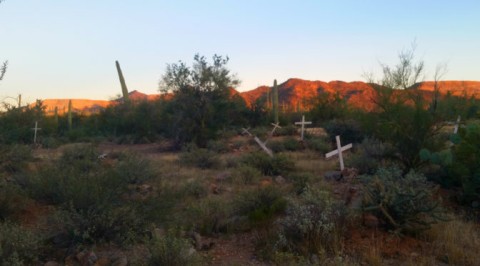The U.S.-Mexico border, where migrants are hunted
What does it do to the body and spirit to be preyed upon constantly?

Sometimes they find people wandering in the south Arizona desert—usually hungry, often lost, almost always dehydrated and desperate. Sometimes they find bodies—if they get there before the vultures and the coyotes. And sometimes they find bones, scattered and bleached by the sun. For the 300 volunteers who call themselves the Green Valley-Sahuarita Samaritans, Ezekiel’s vision of the valley of dry bones is one that tragically resonates—as does the familiar Psalm 23, “Yea though I walk through the valley of the shadow of death.”
Every week these Samaritans conduct compassionate searches around the Arizona-Mexico border, giving aid to migrants who need it. They gather up cherished possessions left behind in the sand: family pictures, icons of saints, a rosary, a child’s backpack, a well-loved doll. They collect signs of dashed dreams—a woman’s high heels and makeup kit, a man’s wide brush for painting houses, cloths used for wrapping tortillas, delicately embroidered with flowers and edged in bright crochet work—found strewn across this unforgiving land.
Read our latest issue or browse back issues.
The Samaritans regularly place 55-gallon drums of drinking water throughout this arid wilderness. With an administration in Washington that is fanning flames of racism and anti-immigrant sentiment, increasingly U.S. Border Patrol agents and members of militia and hate groups slash the drums or shoot them full of holes. One Border Patrol agent admitted that destroying water stations was part of his training.
In response to the Trump administration’s effort to impose a zero tolerance approach to immigration and separation of children from their parents, the Southwest Conference of the United Church of Christ called for a convergence of clergy and laity in south Arizona during the last week of August to make a “faithful witness” at the border and to encourage congregations to support asylum seekers. One of a hundred participants from around the country, I left the experience haunted by the suffering of migrants, and by the question: What does it do to the body and spirit to be constant prey?
In 1994 the North American Free Trade Agreement opened the way for the United States to flood Mexico with heavily subsidized corn and other produce, undercutting livelihoods and forcing two million Mexican farmers to lose their land. Massive poverty fostered an explosion in gangs and drug cartels with their ghastly violence, both in Mexico and in Central America, pushing an unrelenting tide of desperate people north.
The U.S. response was a ballooning of the Border Patrol from 4,000 agents to 21,000. An ironfisted policy of “prevention through deterrence” went into effect: treat migrants with such harshness that they won’t even think of coming here. It’s cruelty by design: imposing economic change that renders life untenable and then criminalizing the flight for survival. Last spring’s zero tolerance policy was a further escalation of the brutality: indefinite detention, tricking and coercing migrants into signing voluntary deportation orders, stealing and caging children. At this writing, 565 children still remain separated from their parents, more than 300 of whom have already been deported and are virtually impossible to locate.
Targeting as prey begins in migrants’ home countries. Rosalinda, a young mother and member of my bilingual women’s group, Mujeres Unidas en Fe (Women United in Faith), is here because her teenage nephew was assassinated for refusing to join a gang—and because children in her village are being kidnapped and murdered by predators who harvest their organs for sale.
The dangerous journey north through the desert makes migrants prey to coyotes both human and animal. Coyote is the name appropriately applied to the smugglers who promise to guide migrants across the border. They work for the cartels that traffic in drugs and human beings. If money for a migrant’s passage isn’t waiting in Phoenix, a coyote will threaten a mother: “Send the money now, or I’ll send you your son’s fingers.”
If a migrant’s journey begins in Honduras, Guatemala, or El Salvador, it may take months to cover the vast 2,000-mile stretch through Mexico—often a horrific nightmare trip on top of hurtling trains under intense sun. On the trains and at every stop, predators lie in wait to beat and rob vulnerable migrants.
Reaching the United States does not mean safety or relief. On our first day at the border, a throng of recently captured migrants was paraded through the federal court in Tucson. Wearing the torn and sweat-stained clothes they had lived in for days or months, they lined up before the judge seven at a time, heads bowed, momentarily unshackled but standing with hands still clasped behind their backs. In an hour and a half the judge sentenced 83 people to detention or deportation as part of Operation Streamline. One young woman from Honduras was visibly pregnant, and I wondered if she left home on her long and perilous trip carrying a child. Eighty to 90 percent of women are raped on the journey north. Prey at every turn.
We crossed into Mexico and stood on a Nogales street corner by the border wall, across from a large mural of José Antonio Elena Rodríguez. Above our heads was a spray of bullet holes over the entrance to a shop. On the night of October 10, 2012, 16-year-old José Antonio was walking to his home four blocks away when Border Patrol agent Lonnie Swartz fired 16 bullets at him through the border fence and killed him, claiming later that the teenager was throwing rocks. Prey in the crosshairs. The federal government refused to release surveillance camera footage of the incident taken from a nearby Border Patrol watchtower, and Swartz was acquitted of murder in April. His trial on manslaughter charges is scheduled to begin on October 23.
Back in the United States, we spread out in front of the Nogales Border Patrol Station, the largest gate on the Arizona side of the border. Holding signs of protest, we prayed, sang, and read a litany of names of migrants who have recently perished in the Arizona desert. Border Patrol agents fanned out across the street. One systematically snapped our pictures.
Traci Blackmon, executive minister of justice and local church ministries for the United Church of Christ, shouted through the bullhorn: “Many have come out to document our presence . . . Many have recorded our pictures. I’m sure that many of us will be matched with our names. Oh, if only so much attention could have been given to the children who are now left here without their parents.”
A two-hour pilgrimage into the desert took us to the site where Miguel Vasquez Lara lost his life. Miguel, one of 3,000 migrants who are known to have perished in the Arizona desert in the last decade, was 26 when he died of dehydration in May 2011. When he couldn’t keep up, his coyote left him behind. A couple traveling with the group stayed with him for a while, pouring water on his body and holding garlic under his nose—a tactic that the coyote said might revive him.
Two crosses mark the place where Miguel’s body was found, part of an effort to mark every spot where a migrant has died. We placed flowers and offered prayers as a multitude of butterflies fluttered around us like a hovering cloud of witnesses. A fighter jet screamed overhead. Our Samaritan guide explained that a bombing range lies near the site. Sometimes migrants mistake the targets for shelters and walk toward them, through land littered with live mines and bombs.
On the walk back under a blazing sun, I counted it a miracle that anyone at all survives the suffocating heat and crushing harshness of this alien landscape. Reaching our van, I was grateful that we didn’t encounter any of the scorpions, tarantulas, or rattlesnakes we were cautioned to watch out for. I took note that we didn’t need to be warned about drug cartels, militia thugs, kidnappers, coyotes, traffickers, thieves—or Border Patrol agents and their watchtowers, floodlights, electronic sensors, thermal reconnaissance cameras, pistols, rifles, Tasers, batons, horses, dogs, drones, and helicopters.
Somali refugee Warsan Shire, whose poem “Home” has become a rallying cry for migrants all over the world, wrote of the two countries she knows: “One is thirsty, the other is on fire. Both need water.” I believe the answer to this immigration crisis is to douse our nation’s raging conflagrations of empire and militarization with our prayers and protest, enabling Mexico and the countries of Central America to be safe and prosperous homes for their citizens.
My image of water breaking forth in the wilderness is a stream of tears. When enough of us are moved by the unconscionable suffering to pour out compassion and cry for mercy, change will come. Then, as the prophet Isaiah envisioned, the desert places will be engulfed with mighty torrents of loving hope, washing away all sorrow and quenching all thirst.
A version of this article appears in the print edition under the title “Preyed upon.” That version incorrectly gives the distance migrants travel through Mexico, which is corrected here.



